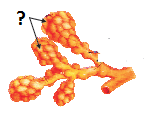10th Grade > Biology
LIFE PROCESSES MCQs
:
A
Nutrition in an amoeba occurs through a process called phagocytosis where the entire organism pretty much engulfs the food it plans on eating up. As amoeba is a unicellular organism, it does not have any specialized organ for the mechanism of nutrition. It directly swallows the whole food and a food vacuole is created. Digestive juices then get secreted in the vacuole and the food is slowly digested. After this, the waste is excreted.
:
C
In our circulatory system, the artery divides into smaller and smaller vessels to bring the blood in contact with all the individual cells. These small vessels have walls which are one-cell thick and are known as capillaries. Exchange of material between the blood and surrounding cells take place across this thin wall. The capillaries then join together to form veins that carry the blood away from the organ or tissue.
:
C
The human heart consists of four chambers: two atria, which are the receiving chambers of the heart and two ventricles, which are the pumping chambers of the heart. A fish heart has two chambers and a frog heart has 3 chambers.
:
C
The process of obtaining food to meet the energy demands of the body is known as nutrition. It is the most important step because without nutrition there will be no energy available for any other life processes. In simple words, it's the fuel which enables the car to run.
:
A, B, C, and D
In order to enjoy a healthy life, all the life processes in our body must function well. A dysfunction in any of these processes can affect the working of other processes and the overall quality of life will be degraded.
:
C
∙ Alveoli are balloon-like structures present in lungs. They provide a large surface area for exchange of gases. Their walls have an extensive network of blood vessels.
∙ Arteries carry oxygenated blood from the heart to all parts of the body.
∙ Air passes through the pharynx into the wind pipe. Both food pipe and wind pipe originate here. It is commonly referred as throat.
∙ Capillaries are the smallest blood vessels in our body where nutrient and waste exchange between blood and tissues takes place.
:
C
Each kidney has a large number of filtration units called nephrons, packed close together. Some substances in the initial filtrate are selectively reabsorbed as the urine flows along the tubular part of the nephron. The urine formed in each kidney eventually enters a collecting tube, the ureter, which connects the kidney to the urinary bladder. Urine is stored in the urinary bladder until the pressure in the expanded bladder leads to the urge to pass it out through the urethra.
:
B
Excess or unused carbohydrates produced during photosynthesis are stored in the form of starch (polysaccharide/polymer of simple glucose molecules) as a reserve of energy for future use in various parts of the plant body.
:
B
Veins collect blood from different parts of the body and bring it back to the heart. They do not need thick walls because the blood is no longer under pressure, but instead, they have valves to ensure that the blood flows only in one direction towards the heart.
:
B
Diffusion is the movement of a substance from an area of high concentration to an area of low concentration. The exchange of gases take place in the millions of alveoli in the lungs and the capillaries that envelop them. Due to the difference in concentration, inhaled oxygen moves from the alveoli to the blood in the capillaries, and carbon dioxide moves from the blood in the capillaries to the air in the alveoli.

















